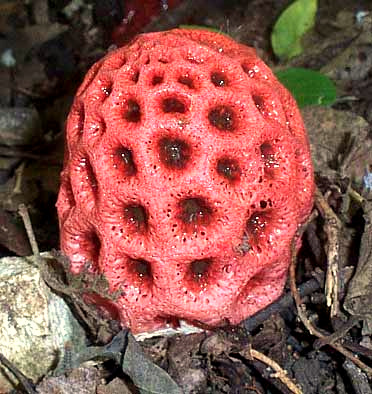Excerpts from Jim Conrad's
Naturalist Newsletter
from the July 27, 2007 Newsletter issued from Sierra Gorda Biosphere Reserve, QUERÉTARO, MÉXICO
WIFFLEBALL STINKHORNS

The strange object shown above is a fungus about the size of a baseball. Note the glistening, greenish-brown, very stinky, pasty goo inside the pores. That stuff's stench attracts insects such as flies who wander into the pores looking for putrefying flesh, mellowing manure and the like. The gunk gets on the insects' legs, they fly away and spread it on whatever they land on. That's good for the fungus since the slime has spores in it, and those spores can germinate to produce new fungi.
The fungus is CLATHRUS CRISPUS, and if it has an accepted English name I can't find it. In the US it occurs in Florida and along the Gulf Coast, but mostly it's found in Mexico and the Caribbean. The species belongs to the fungus family Phallaceae, that name based on the obvious English root. Longtime readers of this Newsletter may remember my January 27, 2002 issue where I reported on finding a stinkhorn in Mississippi. Country folks back there were liable to call the slender, pointed, red stinkhorn a Dog-pecker Mushroom, because that's what it looked like, and it smelled like this week's Clathrus crispus. Several other outlandish-looking stinkhorn species exist and you might enjoy browsing "The Stinkhorn Hall of Fame" at http://www.mushroomexpert.com/stinkhorn_fame.html.
About a dozen of this week's stinkers grew in a heavily shaded patch of scrub across the fence from my casita. I suspect that the reason the fungus grew there so gregariously but not anyplace else I visited during my hike is that sometimes folks from the shantytown next to the reservoir take craps there. Clathrus crispus is "saprobic," which means that it derives its nourishment from nonliving or decaying organic matter. Old crap that's worked its way into the soil must look pretty good to it.